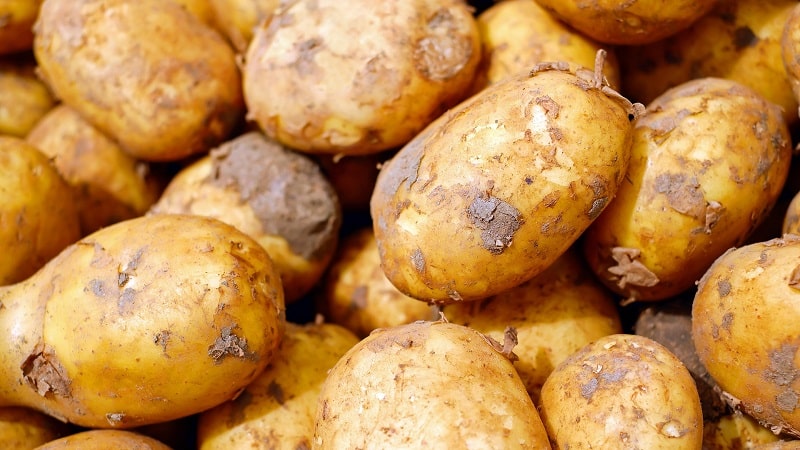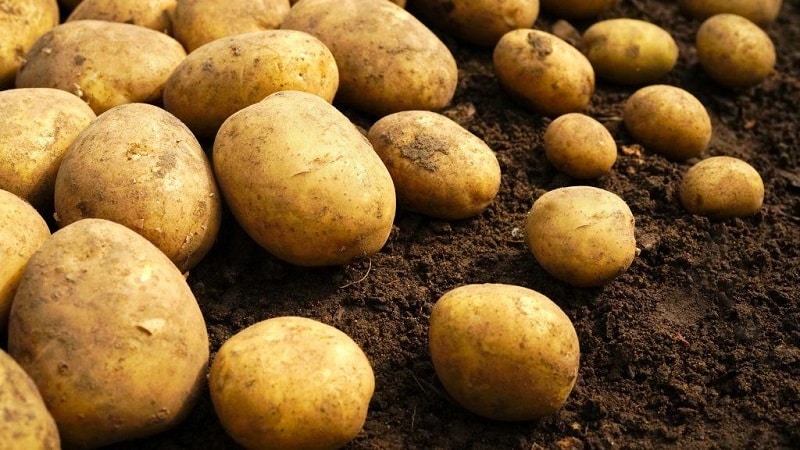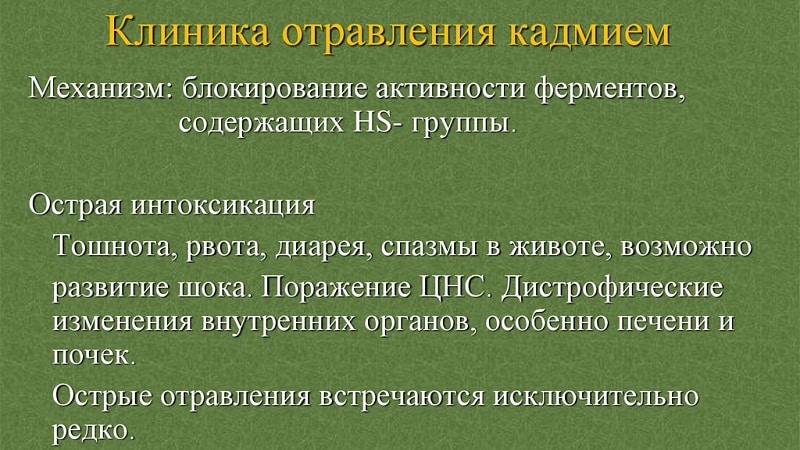How to check for the presence of cadmium in potatoes, and why it is dangerous for humans
Many potato lovers do not suspect that the usual product can cause poisoning with the heavy metal cadmium. Therefore, buyers and summer residents should know how to eat potatoes without harm to health.
What is cadmium
Cadmium is a widespread chemical element that can accumulate in plant and animal organisms.. Its cumulative effect at higher doses is fatal.
The metal has a detrimental effect on the body's systems - this is due to the ability of cadmium to modify sulfur-containing compounds and amino acids. By connecting them, it rearranges the work of all glands that produce enzymes and hormones. This leads to disruption not only of hormonal levels, but also to a disorder of the nervous system, since cadmium destroys bone tissue and protein.

Cadmium enters the human body every day. The norm of consumption is 2.5 mcg per week per 1 kg of weight. Severe poisoning is possible by inhaling cadmium vapors (up to 2.5 g/m³ of cadmium oxide for 1 minute). The main symptoms are severe pain in the joints and bones, vomiting, anemia and convulsions.
Reference. High risk of intoxication among workers in the mining industry. However, lovers of shrimp and mushrooms also have cause for concern. The cadmium content per 1 kg of these products reaches 1.2 mg and 160 mg, respectively.
Where does cadmium come from in potatoes?
Cadmium does not occur in nature in its pure form. Its atoms are scattered in soil, water, and minerals.He is a constant companion in mines, in places of extraction of zinc, copper and salts based on them.
The cadmium content in potatoes is determined by several factors. If the plants were treated with cheap phosphate fertilizers (without quality certificates), the substance norm will be exceeded. This is explained by the fact that many mineral fertilizers contain cadmium as a natural impurity element.
Phosphates saturated with cadmium provoke the crop’s ability to absorb this element from the soil in even greater quantities. During harvest, fertilized potatoes may contain significant doses of cadmium. Exceeding the norms is always associated with overfertilization, non-compliance with the rules when working with chemicals, and the desire to increase productivity while saving on fertilizers.

The main routes of potato contamination with heavy metals are associated with natural factors, first of all, the soil on which the vegetable grows. If metallurgical or chemical production is located near cultivated fields, the content of cadmium and other metals is always exceeded.
Some of the compounds end up in the soil as a result of the discharge of processing waste into rivers, the other part falls in the form of precipitation, harmful condensate with cadmium vapor. The ratio is calculated as 70/30. That is, the main source of cadmium is soil with rivers and canals that are used for irrigation.
Interesting things on the site:
What does raw potatoes help with and can you eat them?
How to determine if potatoes contain cadmium
The task of determining the cadmium content in vegetable crops cannot be solved in practice. An ordinary buyer or summer resident will have to order a laboratory examination at his own expense, where the presence of cadmium and its concentration are determined using reagents (sulfides). The more substance there is in the tuber, the more pronounced the yellow color the pulp acquires.
In Russia, the maximum permissible mass of metal is no more than 0.03 mg per 1 kg of fresh potatoes. In Europe, this figure is lowered to 0.025 mg/kg. This is due to the increased content of cadmium in soils, in particular in Germany, where about 100 thousand people already suffer from kidney failure due to the abuse of phosphate fertilizers.
Important! Nitrate testers do not even help determine the content of nitrates themselves. Their device is based on measuring the electrical conductivity of salts. The only thing that can be determined from these devices is the total concentration of salt compounds.
The content of cadmium in everyday life is determined by the appearance of the tuber. Potatoes cannot contain a lethal dosage (150 mg/kg), but given that the crop forms the basis of the diet in many Russian families, it will be useful to know which product is not worth buying:
- Due to the direct relationship between the content of phosphates and cadmium in potato tubers, a vegetable without traces of overfertilization is chosen.
- Tubers should be smooth, without dots, spots and uncharacteristic formations of a different color.
- The pulp should not be bitter, have an unpleasant odor or cause digestive problems. When cut, the flesh should remain uniformly firm, crisp, and without excess liquid.
- If you try to pierce the skin with a fingernail, the “stuffed” potatoes will not emit the characteristic crackling sound, and excess juice will come out of the pulp, which in season means clear evidence of overfertilization of the crop.

For home analysis, use the following method:
- Cut the potato into 2-3 mm slices.
- Select a slice from the core and the one closest to the edge.
- If both make the same sounds when broken (dull crackling), then the tuber is safe for consumption. When cooked, the vegetable will be cleared of 70% of harmful nitrate formations.
- If the slices “sound” differently, the vegetable is potentially dangerous. Nitrates and phosphates are collected under the skin of the fruit, in the pulp (1-2 cm). If juice emerges from the core when cut, and the pulp itself is dense, the entire vegetable is “fertilized.”
On average, 1 kg of potatoes contains 0.006 mg of cadmium. Depending on soil fertility and territorial location, this indicator varies. Removing this toxin is almost impossible. By the age of 50, every inhabitant of the planet accumulates about 50 mg in the body. And this takes into account the fact that every 10 years the body is freed from half of its total content.
Why is it dangerous for humans?
The danger of cadmium is determined by its ability to accumulate in tissues. There are also radioactive isotopes that cause irreparable changes in cell nuclei. The effects of this heavy metal are hidden from human eyes. Symptoms of poisoning appear at the stage of destruction of bones, the excretory system (liver, kidneys) and disruption of enzymatic functions (including the endocrine system).
Important! Cadmium is classified as a highly hazardous metal (class two). Entering the body through the blood (digestion, respiration), it mainly accumulates in the kidneys, liver, tubular bones, pancreas and spleen.
Excreted from the body primarily through bowel movements (up to 48 mg per day). The remaining part causes toxic poisoning over time.
Mechanism of action:
- disrupts phosphorus-calcium and salt metabolism;
- causes deformation of protein cells by binding to them;
- destroys the tubules of the liver and kidneys, which leads to the inability to properly cleanse the body without losing useful microelements, promotes the formation of kidney stones;
- destroys bones - this leads to fractures for no apparent reason, deforms the skeleton;
- interferes with lung ventilation, causing shortness of breath;
- causes severe pain in muscles, joints and spine;
- capable of degenerating tumors into malignant cancerous neoplasms;
- neutralizes the effects of zinc, selenium, iron;
- destroys the immune system;
- increases blood pressure, causing hypertension;
- negatively affects the glands, restructuring their work;
- deactivates the work of the ovaries and testes.
Signs of poisoning appear gradually or instantly in case of acute poisoning by vapors (cadmium oxide and salts).

Symptoms of intoxication:
- acute muscle and bone pain;
- vomiting, diarrhea, often with blood;
- pain in the stomach;
- pulmonary edema (in case of vapor poisoning);
- weakness, chills, high temperature;
- spasms and cramps in the sternum and abdomen.
The degree of poisoning largely determines the course of the disease. For food poisoning (10-30 mg at a time), the symptoms are similar to poisoning from stale food or water. Body systems gradually fail. Most often, a person understands what food makes him sick and turns to a doctor for help. Modern biochemical tests make it possible to determine the increased content of cadmium in the urine and take timely measures.
Read also:
Recommendations from experts
Treatment of cadmium poisoning is a long process. The patient is prescribed special injections, rest, walks in the fresh air and a special diet. Death occurs only with prolonged exposure to fumes and dust with metal.
To reduce the harmful effects of cadmium, experts advise consuming it daily with food. daily requirement of vitamins and minerals. For the purpose of prevention, intravenous injections of vitamins and dietary supplements with zinc, copper, selenium, iron and phosphorus are prescribed.
For safe nutrition, doctors advise consuming exclusively boiled tubers.. And summer residents are advised to use only organic fertilizers and liming the soil.
Conclusion
Cadmium contained in potatoes can cause harm to health at any age. The concentration of the element in the soil where the vegetable grows is constantly increasing. To reduce the likelihood of poisoning when purchasing, tubers should be checked for the presence of nitrates.